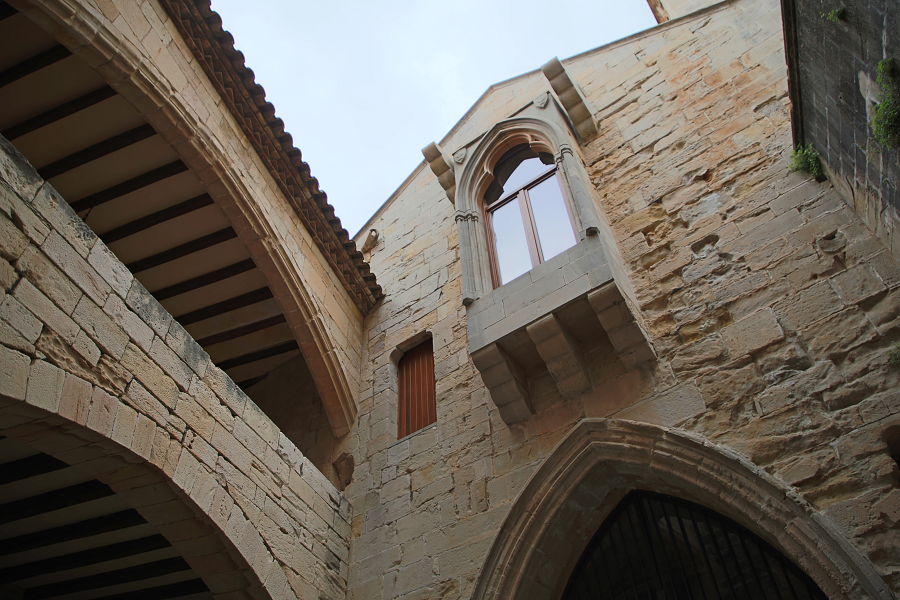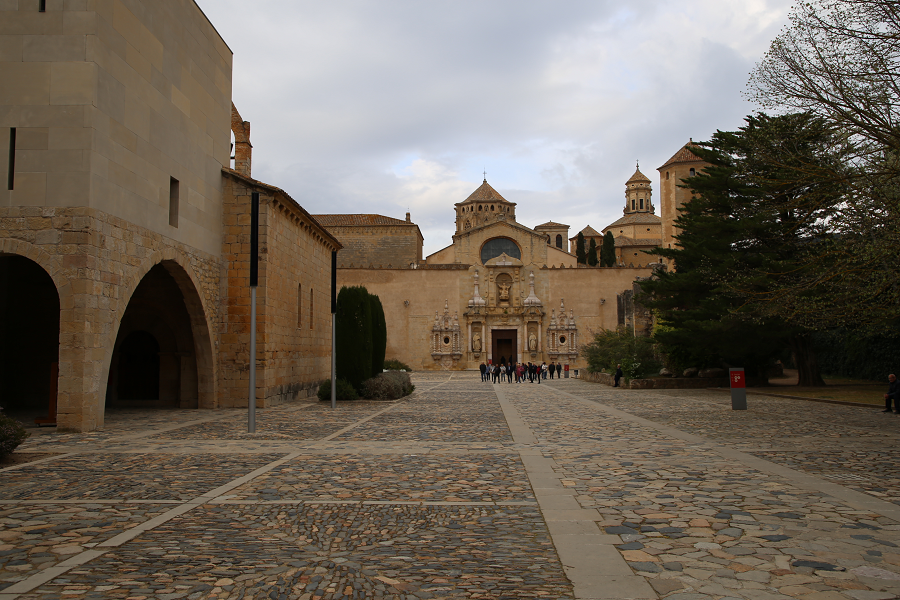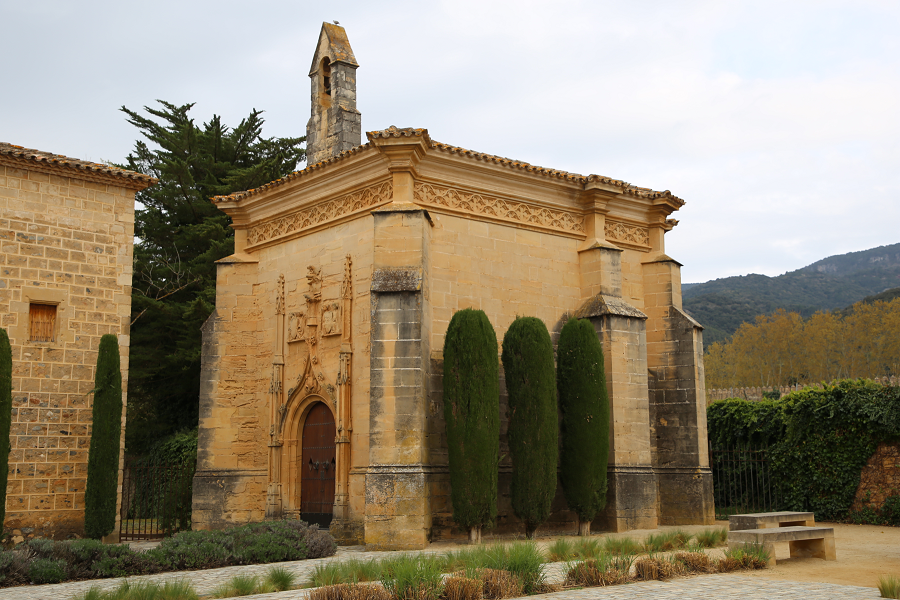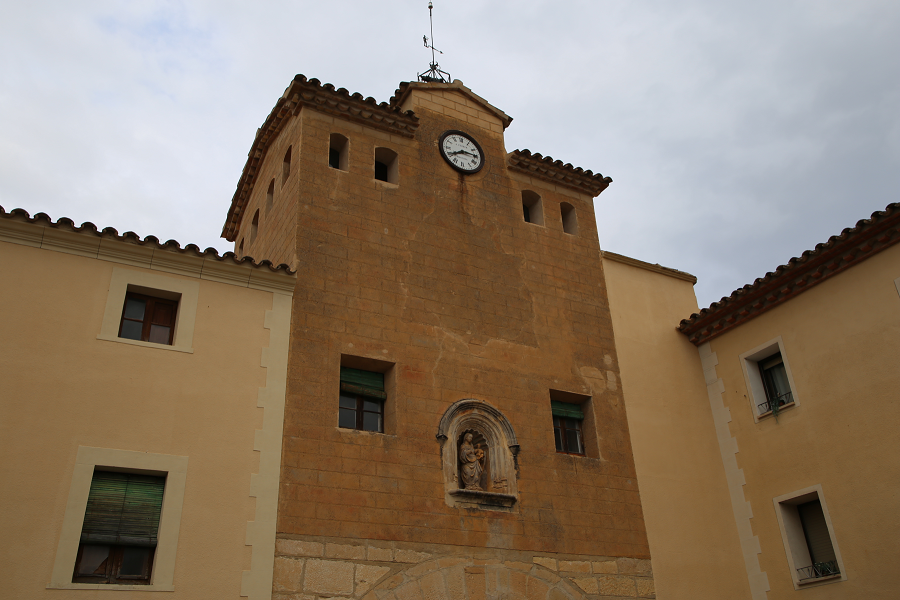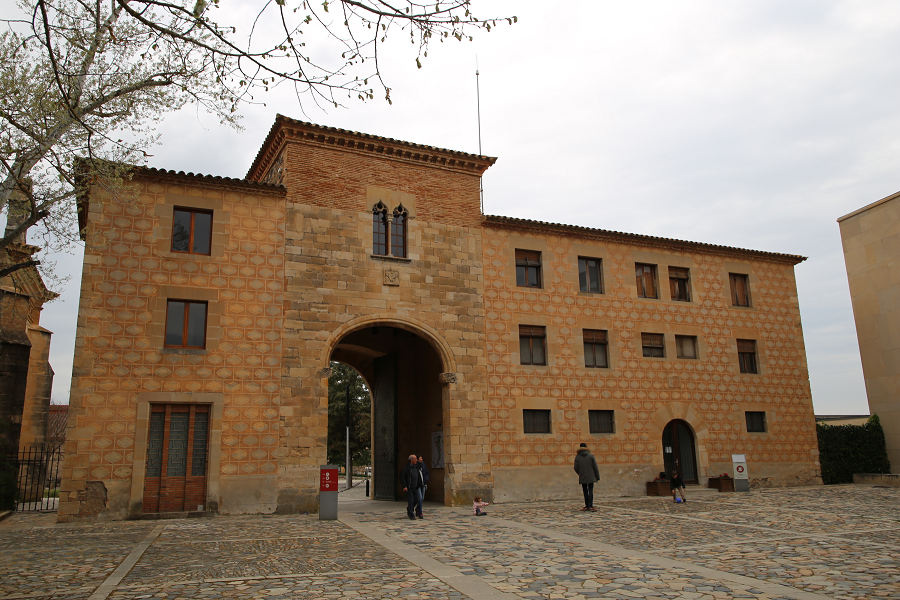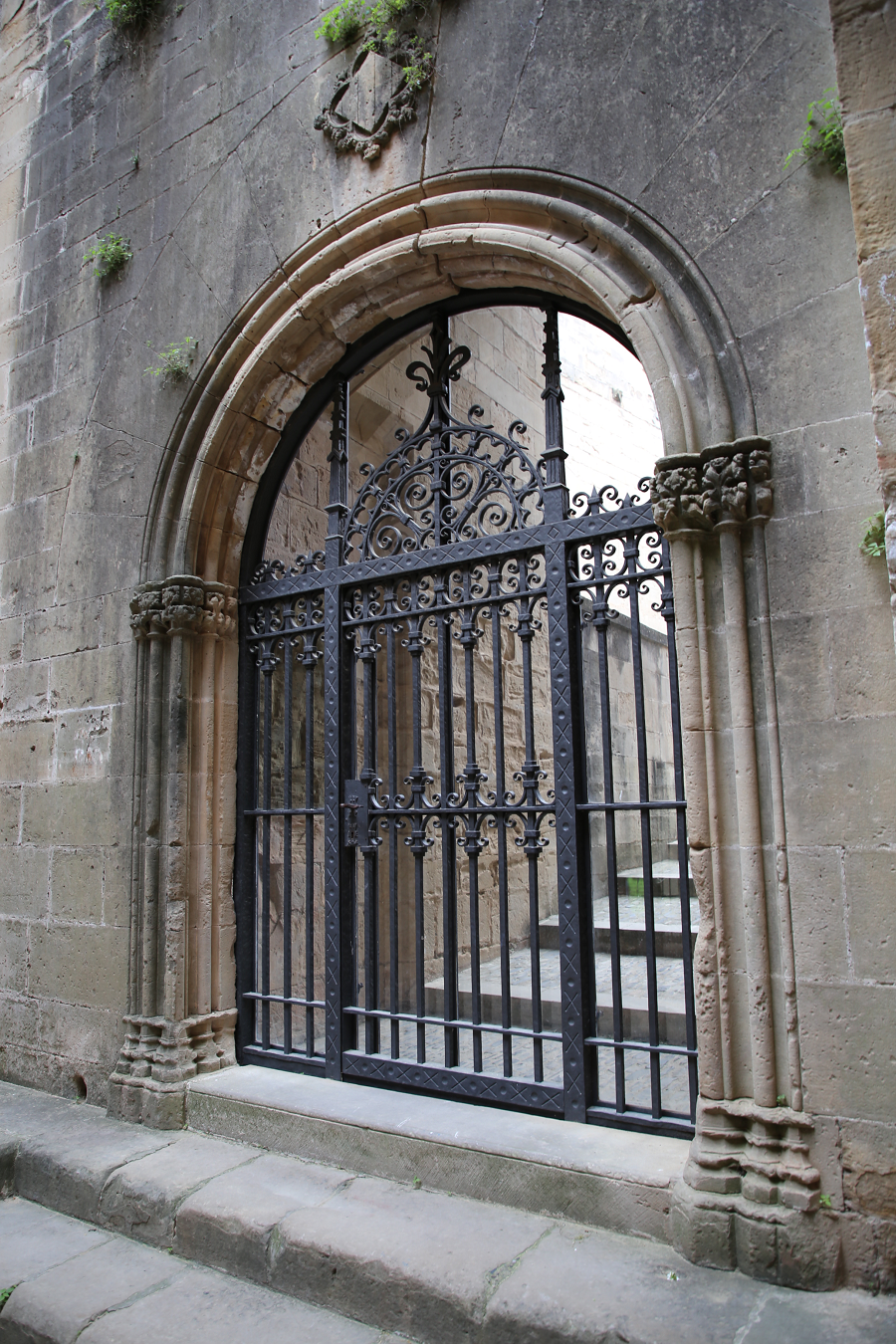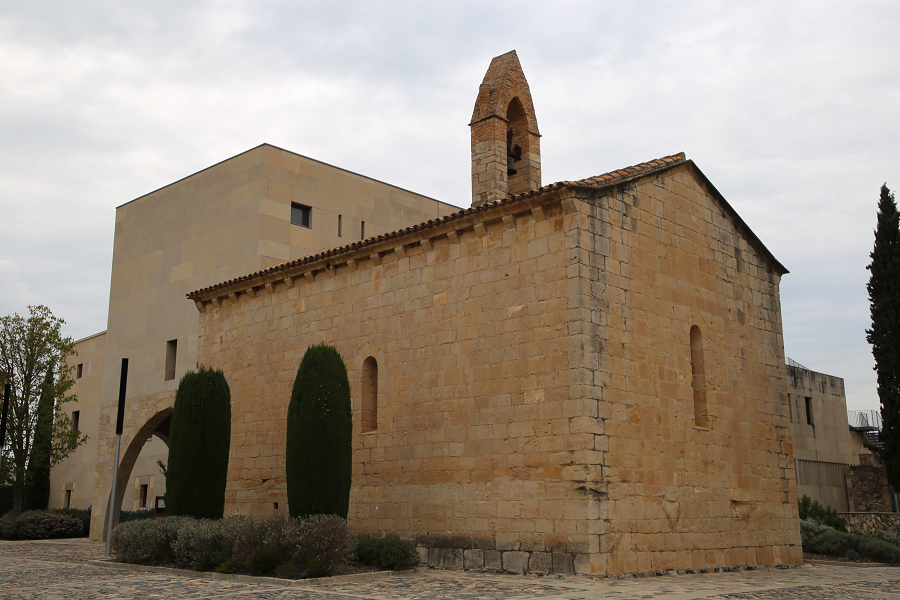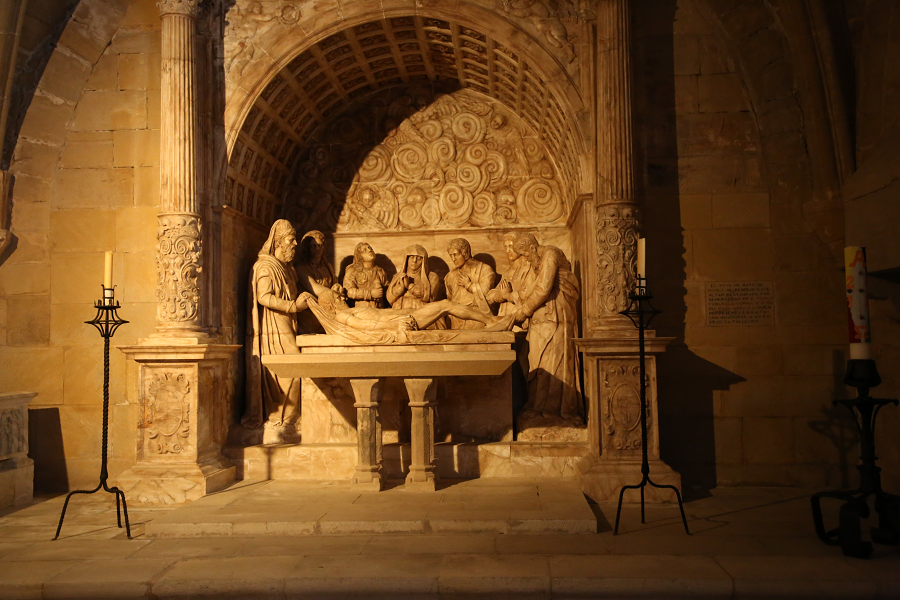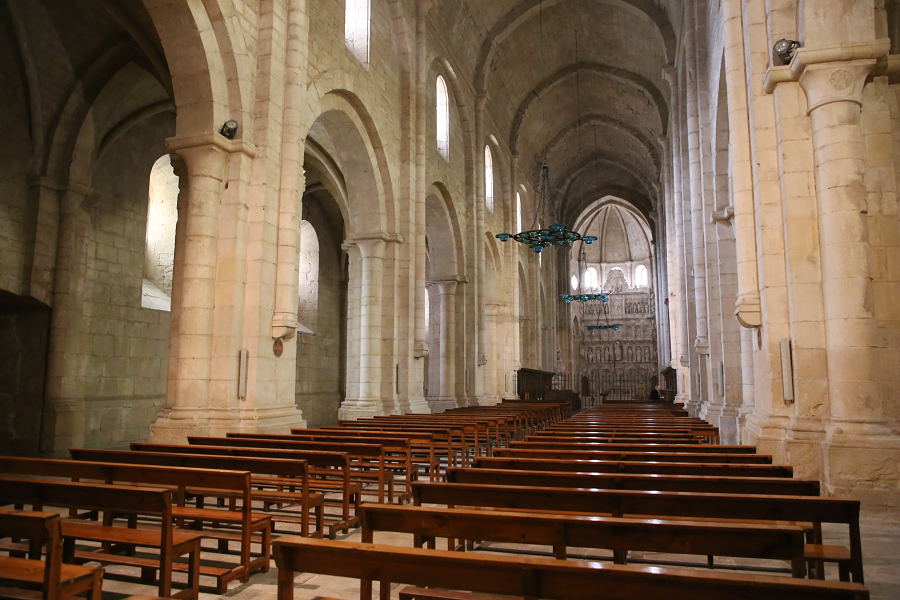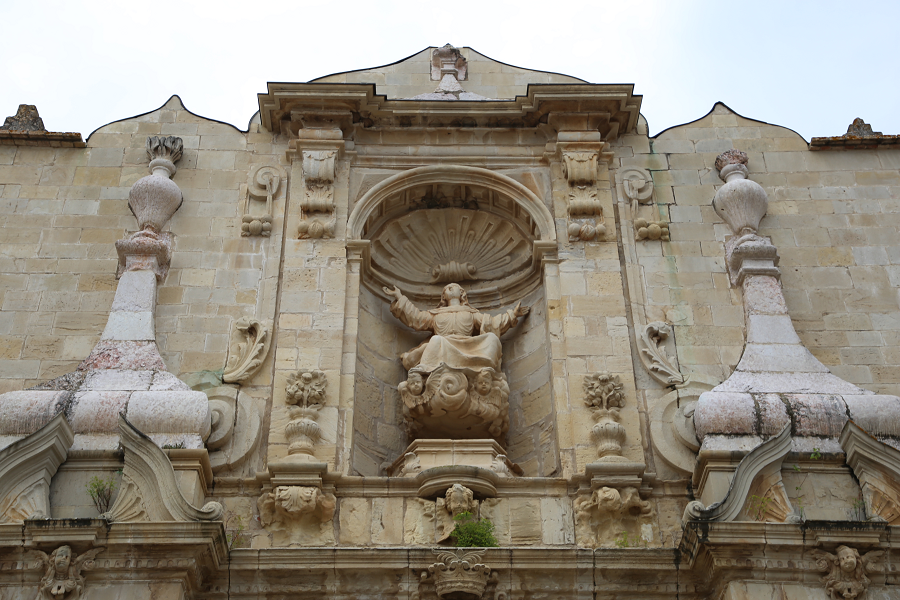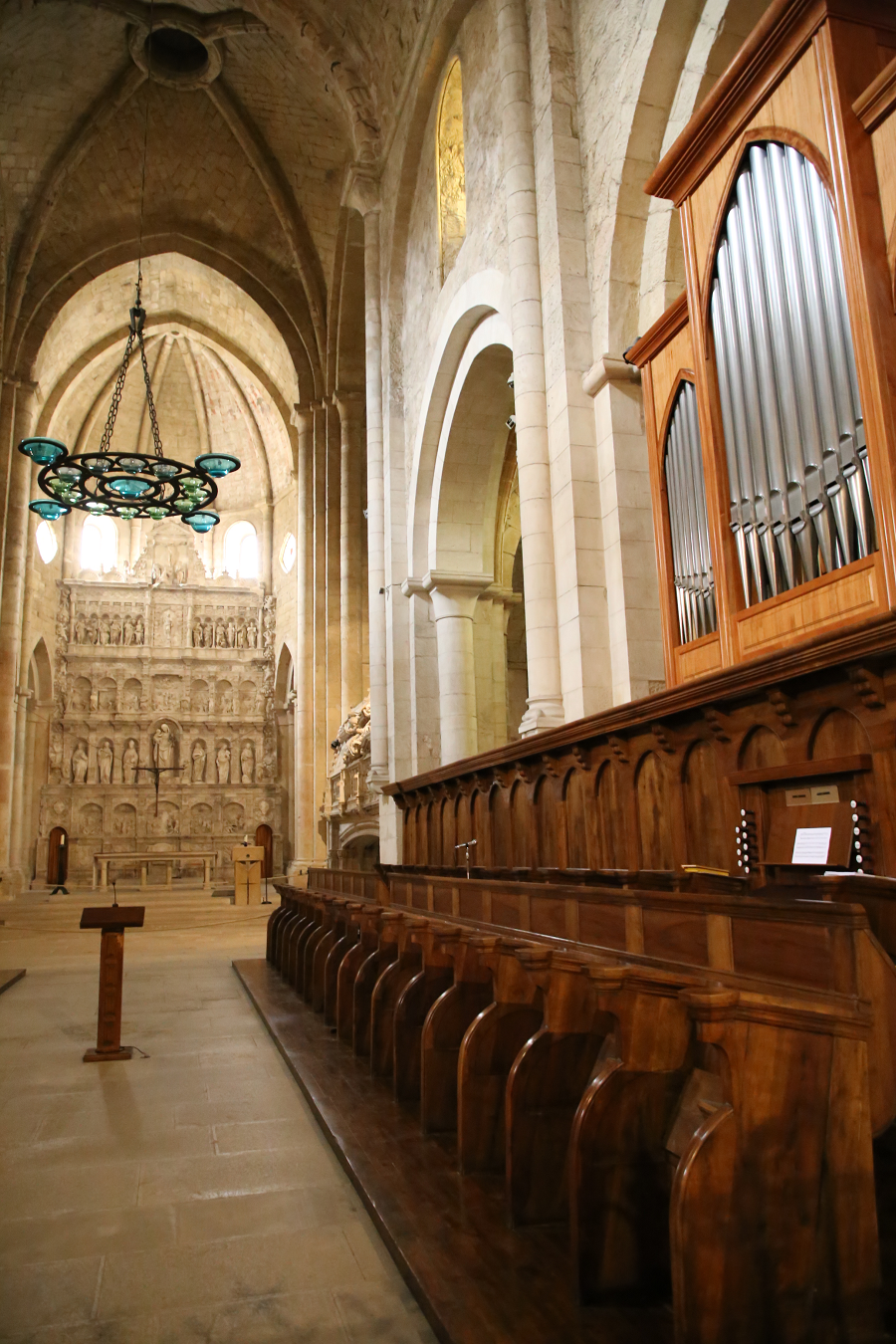The Royal Abbey of Santa Maria de Poblet (cat. El Reial Monestir de Santa Maria de Poblet) is a monastery of the Cistercian order founded in 1150. It is located at the foot of the Prades mountains in the comarca Conca de Barberà, Catalonia, Spain. Poblet is an impressive architectural complex and can be counted among the most important monasteries in Europe, in fact it is the largest monastic habitat on the European continent. Since the Middle Ages, it is an important symbolic reference point for the countries of the old Crown of Aragon.
It belongs to the municipal district of Vimbodí and Poblet and ecclesiastically it belongs to the parish of Sant Miquel de l’Espluga de Francolí (of the archdiocese of Tarragona), both these towns are near the town of Montblanc, and have very close ties with the monastery.
Since the reign of Peter the Ceremonious and during the 14th and 15th centuries, it became the royal pantheon of the sovereigns of the Crown of Aragon, although it also housed the tombs of some former monarchs, and other individuals of the royal family and of different nobiliary lineages.
In 1921, after the visit of King Alfonso XIII, it was declared a National Monument by the Spanish Government. In 1991 it was declared a World Heritage Site by UNESCO.
In 2005 it received the distinction of Creu de Sant Jordi of the Generalitat de Catalunya “for its important role in the history of Catalonia from the 12th century, when, with the introduction of the Order of the Cister, it became one of the Spiritual assets of the Crown of Aragon, of whose royal tombs the monastery is the main house. This monastery, declared a World Heritage Site by UNESCO, on the Cistercian Route, today is a reference point for cultural tourism”.
History
The history of the Poblet monastery has been closely linked to that of the rest of Catalonia.
Foundation and enlargement
The Royal Abbey of Poblet was founded on August 18, 1150, when Ramon Berenguer IV, upon completing the conquest of Lleida to the Saracens, gave to the abbey of Fontfreda some lands of the Conca de Barberà, so they could establish a Cistercian monastery. This donation had two purposes: a spiritual one (to create a focus of Christianization in lands conquered from the Saracens) and an economic one (to cultivate empty and abandoned lands).
The new monastery was to become a place of work and prayer. Therefore, in 1151 a small group of monks arrived at Poblet and in 1153, once the last Saracen refuges of Prades and Siurana de Prades were conquered, twelve monks took possession of the lands. The community had just been established. The new community began the construction of the church, which, following the Marian tradition of the Order, was consecrated to Santa Maria.
The initial patrimony of the monastery was increased with new donations from the same Ramon Berenguer IV, as well as from landlords and lords who gave goods and lands to the community in exchange for being considered “family members” of the monastery, to participate in spiritual goods and to be buried there. The manorialism of Poblet became the largest in Catalonia, after the one of the dukes of Cardona. It included six baronies (Abadiat, Prenafeta, Segarra, Urgell, Algerri, Les Garrigues and the Quart de Poblet in Valencian community), thirty-four villages and thirty-seven hamlets, several farms and five priories, as well as benefits in various churches. In addition, it included grazing rights in Cerdanya and Berguedà, and fishing in Empúries and in the pond of La Pineda, near Salou (this last right is important, if we consider the meat abstinence of the Order).
King Alfonso de Chaste (1172-1196) made numerous donations for its works and was a key player in the future of the monastery, to the point that he decided to be buried in Poblet, and at his death he donated to the monastery his royal crown and the royal lands of Vinaròs and Palomera (Lleida). His grandson, James the Conqueror, continued enlarging the monastery. In 1232 he revoked his previous decision to be buried in Sixena (Aragon), a place of burial of his father, Peter the Catholic, and instead he chose Poblet. In addition, in his will, he donated to the monastery five thousand morabats, his gold ribbon, eight hundred kilograms in silver cutlery, precious stones and rings, and his personal oratory chapel. In addition, he donated many possessions, villages and castles, partly thanks to his conquests.
Ponç de Copons, abbot of Poblet between 1316 and 1348, advocated important remodelings to the monastery and during the period of his abbotry the dome was built (prior to 1339), as well as, the vaults of the south nave and the chapels facing the north part of the church. Traces of those transformations remain marked with the emblem of the abbot: a flake.
King Peter the Ceremonious protected the abbey, enriched it and turned it into a symbol of the dynasty and the state, as at the same time he wanted to have a fortress between Lleida and Tarragona. With this intention, he fortified it, raising walls with twelve defense towers and portals for easy protection. He had firm conviction to finally finish the construction works of the monastery. He donated his collection of history books to the monastery library with the condition that his coat of arms with royal weapons gets sculpted there. He got buried there and made the pantheon of the Crown of Aragon. His son, Martí l’Humà, also resided there often and built himself a palace, at the entrance of the walled enclosure, near the monumental Royal Gate.
The kings of the Trastámara dynasty also gave privileges and numerous donations to Poblet. King Ferdinand of Antequera visited Poblet several times and remembered about it in his will. His son, Alfonso the Magnanimous, sent from Naples two coffers with ornaments to the church and granted it an annual allocation of one hundred gold florins.
King John II buried his son, Charles Prince of Viana, in Poblet, as well as his wives. When he was widowed for the second time, he gave the monastery a hundred sous annually for a perpetual mass, and in her lavish burial he donated her jewels. It was the last royal grave in Poblet, since his successor, Ferran el Catòlic, was not buried there. However, the Catholic King was a great benefactor of the monastery and, in 1509, he gave it the sanctuary of Tallat as a priory.
The Catalan nobility also made donations to the monastery and, in a good number of cases, decided to be buried there. Among the nobility who had family pantheon in Poblet stand out the Cardona dukes, who, at the time, were the patrons of the monastery.
Throughout centuries, Poblet was an important center of temporary power, protected both by the kings of the Crown of Aragon as well as the Catalan nobles, it acted as a powerful feudal lord until the end of the Old Regime.
Exaggeratedly, but also somewhat correctly it was said that its abbot could move from the Pyrenees to Valencia without leaving his domains. Indeed, thanks to the donations of kings and nobles, the monastery came to have, at the time of its greatest splendor (14th and 15th centuries), jurisdiction over seven baronies and seventy villages and hamlets, and the power to appoint mayor’s of ten towns. In addition, Poblet came to have a certain influence and political importance, most importantly the abbots Juan Payo Coello and Francesc Oliver de Boteller, who were presidents of the Generalitat in the 15th and 16th centuries. Poblet was also an important cultural center, with a substantial library, expanded by monarchs and the dukes of Cardona (Pere Antoni d’Aragó), and a desk for writing books copies. Among the volumes that came out from Poblet there is the oldest preserved manuscript of the Chronicle of James I, copied by the abbot Copons in 1343.
During the War of Succession, Poblet supported the pretender of the house of Habsburg, because of the fear of the absolutism of the French Bourbons. Once the aspiring Bourbon was crowned king under the name of Philip V, the monastery went through a delicate situation.
In 1809 the monastery was looted by the French and confiscated in 1811, but in 1813 the monks were able to be reinstated.
During the Trienio Liberal (1820-1823), the anti-clerics plundered the monastery, which got considerably damaged, they burnt the altars, the 16th century dome, the organs, the sacristies, the sacred treasure, the imagery and the wooden benches. The royal tombs, on the other hand, were respected. The Palace of Abad Copons and the dependent farms of the monastery were plundered.
The end of the anti-cleric period of the Trienio and the beginning of the First Carlist War, in 1834, culminated with new attacks on the property of the Church, which had been taken on by the Carlists. Poblet was no exception. In 1835 the exclaustration of the fifty monks, eleven converts and eleven novices of Poblet took pace together with the sale of all their properties. The monastery passed into the hands of the State and was left abandoned, at the hands of looters and vandals.
The looters looked for treasures which they believed were hidden by the monks at the monastery. Consequently, they broke the side walls of the sarcophagi in search of the supposed royal jewels and left the remains of James I, Peter the Ceremonious, John I and the wives of the latter scattered on the floor of the church. Other tombs were also opened, but the bodies were not taken out from the sarcophagi. The parish priest of Espluga de Francolí, Antoni Serret, was not granted permission to collect the scattered remains of the monarchs until two years later (1837).
 He and his colleagues wrapped them up and transported them by car to the church of l’Espluga, where they were guarded along with those of about twenty more members of the Royal House of Aragon. In 1841, Josep Criviller Mn. Serret rescued the bodies that still rested in the tombs, including those of Alfonso the Chaste and Ferdinand of Antequera, from the ruin and unstoppable looting of Poblet, mainly by the people of the surrounding villages. The city council of l’Espluga de Francolí decided to place the remains in boxes; those of Jaume I were deposited in a box of walnut wood and the rest in seven boxes of pine wood. The city of Valencia tried to secure custody of the remains of James I, but in 1843 they were transferred to the cathedral of Tarragona, where a funeral monument was built for James the Conqueror.
He and his colleagues wrapped them up and transported them by car to the church of l’Espluga, where they were guarded along with those of about twenty more members of the Royal House of Aragon. In 1841, Josep Criviller Mn. Serret rescued the bodies that still rested in the tombs, including those of Alfonso the Chaste and Ferdinand of Antequera, from the ruin and unstoppable looting of Poblet, mainly by the people of the surrounding villages. The city council of l’Espluga de Francolí decided to place the remains in boxes; those of Jaume I were deposited in a box of walnut wood and the rest in seven boxes of pine wood. The city of Valencia tried to secure custody of the remains of James I, but in 1843 they were transferred to the cathedral of Tarragona, where a funeral monument was built for James the Conqueror.
The monastery was looted consciously, converted into a quarry for nearby villages and it was at the mercy of anyone coming into it. The Monuments Commission of the Province of Tarragona, a body responsible for the monastery since 1857, did not improve its situation, since the vultures were protected by the local civil servants and by the very civil governor, who gave licenses for the search of supposed treasures hidden by the monks, because of the legends of the ancient splendour of the monastery. The Spanish government seriously neglected the protection of the monument, unlike what was done with other Spanish royal pantheons. In fact, Poblet was not recognized as a ‘national monument’ until 1921, after the visit of King Alfonso XIII, who, referring to the state of conservation of the monastery, declared that it was “a national shame” and promised to promote restoration.
Restoration
Poblet survived in this situation of uncertain protection for almost a century, with little more than consolidation works. But the clamour was growing between part of intellectuality to address this state of affairs, as a historical and national symbol that the monastery represented. Until finally in 1930 the restoration began with the patronage of the Patronat de Poblet, presided over by Eduard Toda i Güell, true soul of the recovery of the monastery. In 1935 they returned to Poblet the alleged mortal remains of Prince Charles of Viana. In 1940, after long negotiations interrupted by the Civil War, a community of Cistercian monks was reinstated, the first ones for 105 years. In 1945 the Germandat de Poblet (brotherhood of Poblet) was created by Father Bernat Morgades, and finally, the remains of James the Conqueror and the other monarchs returned to the monastery, on June 4, 1952, after the restoration of the tombs carried out by Frederic Marès with the sponsorship of the Spanish government.
The Franco dictatorship exploited this restoration, to the point that Franco himself presided over the ceremony of return of the royal remains, and thus attracted the attention of anti-fascist resistance groups, who tried unsuccessfully to keep the remains of Jaume I, with the intention of depositing them in the north-Catalan monastery of Sant Miquel de Cuixà as a protest.
The recent acknowledgments, mentioned at the beginning, culminate a long process of restoration, which has continued without pause until recovering virtually all that was lost.
The Royal Pantheon and other tombs
The main church of Poblet (Santa Maria) and other monastery sites served as a burial ground for monarchs, their children and other people of the Crown of Aragon, members of other important nobility, abbots and monks of the monastery and other prominent people.
Between the two pillars directly on the main altar there is the Royal Pantheon, placed on two large arches, one next to the side of Epistle and the other to the one of the Gospel. The rest of the graves of the royal family are in the crypt-ossuary or in various places inside the temple, such as that of the prince of Viana, located on the right of the main entrance.
Among the nobiliary who chose Poblet for their pantheon it is worth mentioning Aragon-Cardona.
The list prepared by the great historian of the monastery Jaume Finestres (1751) is the main point of reference, and often unique, to know the identity of people buried in the monastery and the original location of their tombs. Many of them are poorly conserved or even disappeared during the destruction of the 19th century.
Peter the Ceremonious, in an agreement with Abbot Copons, decided in 1340 to convert Poblet into an official pantheon of the Casal d’Aragó. In the following years the king commissioned the works, to master Aloi, to Jaume Cascalls and also to Jordi de Déu, some of the best sculptors in the country, who by the will of the monarch worked the tombs with the finest alabaster of Catalonia, the one of the quarries of Beuda. The king followed those works closely. In the magnificent tombs, the lying figures had lions sculpted at their feet, a symbol of strength and power, while the queens had dogs, a symbol of fidelity and loyalty. The tombs were originally covered by wooden baldachins, gilded and decorated in the interior, with a representation of the sky and the firmament, which have not been reconstructed.
Scientific research on pantheons
The profanation of the tombs, the circumstances of their rescue and their transfers of the 19th century have led to the fact that the great majority of the human remains kept in the Royal Pantheon could not be identified with certainty, except those of some monarchs. Since the reinstatement of the royal remains, in the restored tombs, in 1952, no studies have been carried out.
The pantheon of the Aragon-Cardona, on the other hand, has been the subject of a recent anthropological study and cleaning and restoration works. This study has determined that the preserved remains are constituted by at least 104 individuals: 6 children under 12, 4 young people, 74 adults, 10 people of mature age and 10 elderly. Many of the bones show that they were exposed to the outside environment for some time, a circumstance that deteriorated them significantly. Similarly, it has been noted that there are very few small bones, which suggests that there was a selection of bones when they were collected after looting of the 19th century.
Legend of the foundation of the monastery
In the 12th century, in an old small and ruinous hermitage in a forest at the foot of the Prades mountains, settled a single hermit, named Poblet. The Moorish king of Siurana de Prades, Almemoniz, owner of the land, imprisoned him three times, but three times the old hermit disappeared miraculously from prison. The Muslim, bewildered, thought it was a divine message. So he prohibited his men to disturb the monk so he could pray peacefully.
The Moorish king of Lleida found out about it and considered it a sign of weakness. He then sent a squad of soldiers who captured the monk and locked him in a dungeon. But Poblet escaped three times more from that Lleida prison. Thus, the Moorish king of Lleida also granted him freedom.
Count Ramon Berenguer IV was secretly in contact with Poblet and asked him for help in recapturing those lands to Muslims. The hermitage of the monk Poblet served as a base from where to attack the Moorish kingdom of Siurana. The Christians managed to beat and rage the Saracens.
Ramon Berenguer IV, grateful to Poblet, wanted to reconstruct his hermitage and enlarge it. He asked twelve Cistercian monks from the Abbey of Fontfreda to settle there under the guardianship of the new abbot Poblet, who also gave his name to the monastery. This ends the legend and begins the history of the Monastery of Poblet.
How to get to?
From Andorra: N145, C14, C1412a, L313, L310, C14, TV2336, T700,
From Barcelona: AP7, AP2, N240, TV7001, T700
From Tarragona: A27, N240, TV7001, T700





